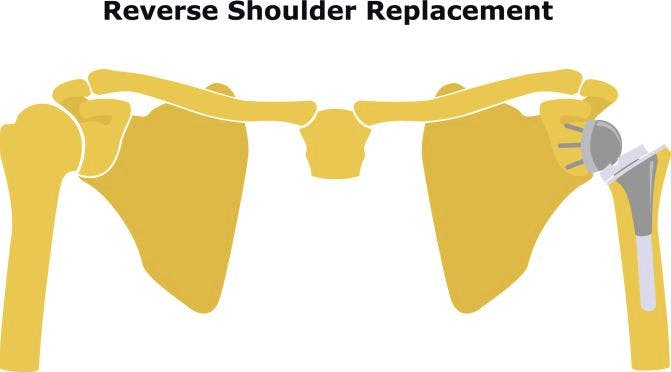Reverse shoulder replacement is becoming an increasingly common surgery. If you are plagued by painful shoulder arthritis along with rotator cuff disease this surgery is an option for you. Also, some types of arm or shoulder fractures are best treated with a shoulder replacement. After surgery, your outcome is largely dependent on your rehabilitation. This article focuses on what is most important during the first month of your recovery.
Early Motion is Beneficial after Reverse Shoulder Replacement
There are two possible early complications following a reverse shoulder replacement. First, it is important to protect your shoulder from dislocating during the first month of your recovery. Your shoulder is most at risk for dislocating when you attempt to reach behind your body. Avoid movements that involve reaching behind your back to dress or reaching into the backseat of your car.

The second common complication is a stiff shoulder. Not moving your arm at all will result in shoulder stiffness. This leads to a poor long-term outcome. A recent study from the University of California showed excellent results when patients began a range of motion exercise 1 week after surgery. Both early exercisers and those who delayed exercise 6 weeks achieved excellent outcomes with very low complication rates. This study suggests both immediate and delayed rehabilitation are safe and effective.
Exercises after Reverse Shoulder Replacement
This article describes 5 exercises we prescribe early after shoulder replacement. We emphasize overhead range of motion. For the first 6 weeks, refrain from performing exercises that involve reaching behind your back. Some pain is acceptable during exercise. However, pain should be minimal and dissipate soon after completing your exercises. Most surgeons advise using a sling for the first few weeks. You want to slowly wean yourself from using the sling to minimize your chance of developing stiffness.
Table Slides
Stand holding a towel with your hand resting on a tabletop or counter. Relax your shoulder and neck muscles. Slowly lean forward and slightly out to the side (a 45-degree angle) while sliding your hand on the table or counter. When a mild stretch is felt, pause and hold the position for 5 to 10 seconds. Avoid exercising through pain.
Waiter’s Bow
Begin standing with your hands resting on a tabletop or counter. Relax the shoulder and neck muscles. Slowly step backward while keeping your hands on the table or counter. When a mild stretch is felt, pause and hold the position for 5 to 10 seconds. Perform 10 repetitions. Avoid holding your breath, bouncing, or exercising through pain.
Washcloth Press Up
Lie on your back with your knees bent. Hold a small towel with your hands close together. Your other arm assists in lifting your involved arm straight up to the ceiling. Straighten your elbow fully. Then pause and hold the position for 5 to 10 seconds. Avoid exercising through pain. Progress this exercise by performing it in a slightly reclined position.
Self-Assisted Shoulder Flexion
Begin lying on your back with your hips and knees bent. With your other hand grasp the wrist of your involved side. Next, passively lift your involved arm overhead. Maintain a straight elbow. Pause and hold the position for 5 to 10 seconds. As your pain decreases progress the exercise by increasing the duration of the stretch up to 30 seconds.
Wand-Assisted Shoulder Flexion
Begin on your back holding a cane or wand in each hand. Space your hands slightly wider than shoulder-width. The cane or wand is grasped between your thumb and index finger in a thumb-up position. The thumb-up position will maximize movement at your shoulder joint. With both elbows straight, lift your arms overhead until a mild to moderate stretch is felt. Hold this position for 5 to 10 seconds. Then slowly lower back to the start position. Perform 10 to 20 repetitions.
Final Thoughts on Rehabilitation after Reverse Shoulder Replacement
We have described 5 safe and effective exercises to begin soon after your reverse shoulder replacement surgery. Start with the 2 or 3 exercises that are most comfortable for you. Perform these exercises 2 to 3 times per day. After a few weeks, perform all 5 exercises several times per day. After 6 to 8 weeks you will be ready to begin some gentle strengthening exercises.
Our next article will go into more detail about the next phase of your rehabilitation. Call us if you have questions or would like help getting started with your post-surgical rehab.


